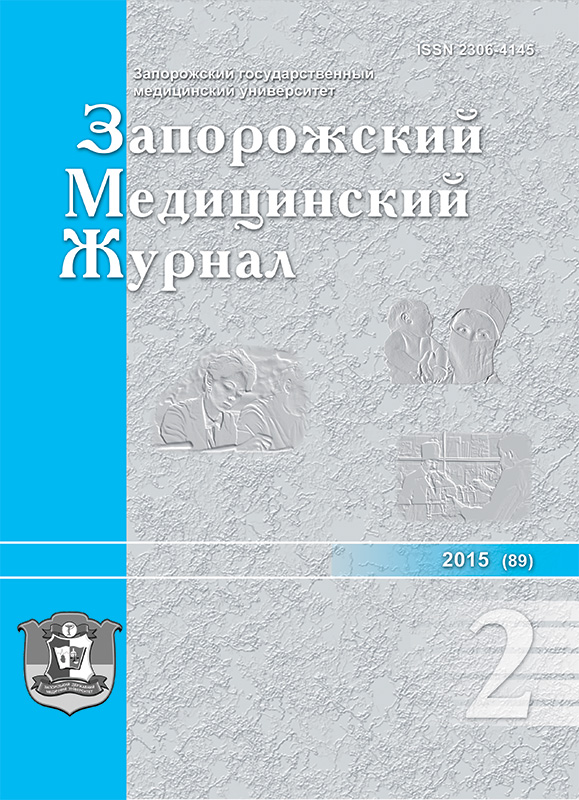Study of the use possibility of the chemical-biological adduct of the 1,1-bis-[5-bromopyrimidine-2’,4’-diono-1’-il]-2-bromo-2’-chloroethylene and bacterial lectin for the treatment of the Pliss’ lymphosarcoma
DOI:
https://doi.org/10.14739/2310-1210.2015.2.42048Keywords:
5-Fluorouracil, Antineoplastic Antimetabolites, Lectins, Lymphatic SarcomaAbstract
Aim. Study of the pyrimidine metabolism antimetabolites that can be preformed compounds in the link of biosynthetic processes and can brake tumour’s growth is a more successful, perspective finding direction of new antitumor medications. New original chemical-biological adduct was studied as potential antitumor agent.
Methods and results. It was obtained on the base of 1,1-bis-[5-bromopyrimidine-2’,4’-diono-1’-il]-2-bromo-2’-chloroethylene and antitumour bacterial lectin from Bacillus polymyxa. It was found that new chemical-biological adduct of bis-derivative of pyrimidine and bacterial lectin has little toxic preparation (LD50=635 mg/kg) and demonstrates considerable antitumour effect upon to 65.5% on Pliss Limphosarcoma tumour.
Conclusion. It confirms that new chemical-biological adduct is perspective for the future investigation as substance with a little toxicity and high antitumour activity on the Pliss Limphosarcoma.
References
Adjei, A. A. (1999). Review of pharmacology and clinical activity of new chemotherapy agents for the treatment of colorectal cancer. Clinical Pharmacology, 48, 265–277. doi: 10.1046/j.1365-2125.1999.00010.x.
Anderson, N., & Lokich, J. (1992). Controversial issues in 5-fluorouracil infusion use. Dose intensity, treatment duration, and cost comparisons. Cancer, 70, 998–1002.
Anttila, M. I., Sotaniemi, E. A. & Kairaluoma, M. I. (1983). Pharmacokinetics of ftorafur after intravenous and oral administration. Cancer Chemotherapy and Pharmacology, 10, 150–153.
Baba, H., Kohnoe, S., Endo, K., Ikeda, Y., Toh Y., Nakashima, H., & Okamura, T. (2000). State of the treatment for gastrointestinal cancer. Gan To Kagaku Ryoho, 27, 1233–1246.
Kleckij, M. E., Cupak, E. B. & Nazarov, D. A. (2002). Struktura i reakcionnaya sposobnost` proizvodnykh uracila [Structure and reactive ability of derivatives of uracile]. Himiya geterociklicheskikh soedinenij, 8, 1106–1108. [in Russian].
Noordhuis, P., Holwerda, U., Van der Wilt, C. L., Van Groeningen, C. J., Smid, K., Meijer, S., et al. (2004). 5-fluorouracil incorporation info RNA and DNA in relation to thymidilate synthetase inhibition human colorectal cancer. Annals. of oncol., 15, 1025–1032.
Longley, D. B., & Harkin, D. P. (2004). Mechanisms of action of 5-fluorouracil. Nature Rev. Cancer, 4, 230–238.
Longey, D. B., Harkin, D. P. & Jonson P. G. (2003). 5-fluorouracil - mechanisms of action and clinical strategies. Nature Reviews. Cancer, 3, 330–338. doi:10.1038/nrc1074.
(2006). Klinitcni protokoly spetsializovanoi dopomogy khvorym na zloiakisni novoutvorennia. Rekomendatsii schodo standartnoi medychnoi dopomogy khvorym na zloiakisni novoutvorennia [Clinical protocols of special helping to the patients with malignant new formations. Reccomendations for standart medical helping to the patients with malignant new formations]. Kyiv: Polium. [in Ukrainian].
Perevodchikova, N. I. (Ed.). (2005). Rukovodstvo po khimioterapiy opukholevih zabolevaniy [Instruction for chemical therapy of cancers’s illnesses]. Moscow: Practical medicine. [in Russian].
Karatsuba, T. A., Sharykina, N. I. & Scheglov, V.I. (2002). Suchasni mozhlyvosti vplyvu farmakoterapii na rist ta protsesy metastazuvannia zloiakisnykh pukhlyn [Modern possibilities of the action of pharmacotherapy on the grows and processes of metastasis of the cancers]. Liki, 1(3–4), 3–6. [in Ukrainian].
Kudriavtseva, I. H., & Sharykina, N. I. (2004). Suchasnyi stan poshuku i vyvchennia FAR z protypukhlynnoiu diieiu sered pokhidnykh kysloty fosforu [Modern situation of finding and learning of PhAS with antitumour action besides derivatives of phosphorus’s acids]. Liki, 1–2, 31–40. [in Ukrainian].
Kudriavtseva, I. H., & Sharykina, N. I. (2004). Suchasnyi stan poshuku i vyvchennia FAR z protypukhlynnoiu diieiu sered pokhidnykh kysloty fosforu [Modern situation of finding and learning of PhAS with antitumour action besides derivatives of phosphorus’s acids]. Liki, 3–4, 40–52. [in Ukrainian].
Prozorovskij, V. B., Prozorovskij, V. P. & Demchenko, V. М. (1978). E`kspress-metod opredeleniya srednej e`ffektivnosti dozy i ego oshibka [Express-method of middle effective dose determination and its mistake]. Farmakologiya i toksikologiya, 41(4), 407–509. [in Russian].
Kovalenko, E`. A., Nagornaya, S. S. & Get`iman, E. N. (2001). Poisk producentov lektinov sredi nekotorykh vidov drozhzhej [Finding of the lectin’s producents besides of some types of yeasts]. Mikrobiolohichnyi zhurnal, 63(5), 44–48. [in Ukrainian].
Blokhin, N. N., & Perevodchikova, N. I. (1984). Khimioterapiya opukholevykh zabolevanij [Chemical therapy of the cancer’s illnesses]. Moscow: Medicine. [in Russian].
Sophjina, Z. P., Syrkin, A. B., Goldin, A., & Klyajn, A. (Eds.) (1979). E`ksperimentalnaya ocenka protivoopukholevykh preparatov v SSSR i SShA [The experimental value of the antitumour drugs in USSR and USA]. Moscow: Medicine. [in Russian].
Downloads
How to Cite
Issue
Section
License
Authors who publish with this journal agree to the following terms:
- Authors retain copyright and grant the journal right of first publication with the work simultaneously licensed under a Creative Commons Attribution License that allows others to share the work with an acknowledgement of the work's authorship and initial publication in this journal.

- Authors are able to enter into separate, additional contractual arrangements for the non-exclusive distribution of the journal's published version of the work (e.g., post it to an institutional repository or publish it in a book), with an acknowledgement of its initial publication in this journal.
- Authors are permitted and encouraged to post their work online (e.g., in institutional repositories or on their website) prior to and during the submission process, as it can lead to productive exchanges, as well as earlier and greater citation of published work (See The Effect of Open Access)

